Ecological Focus Areas
Date published: 11 July, 2025
For recent changes to this guidance, please see the bottom of the page.
This guidance is effective from 1 January, 2026.
Table of Contents
- What is an Ecological Focus Area?
- I'm organic – am I compliant?
- Do the EFA requirements apply to me?
- What counts as arable land?
- What counts as permanent grassland for EFA calculation?
- EFA Area Calculator
- EFA Compatibility Matrix
- How much does each of these options contribute to my EFA commitment?
- Where can I put my EFA?
- Agri-Environment Climate Scheme (AECS) participants
- EFA mapping requirements
- Map viewer
- EFA fallow land (EFAFAL)
- EFA margins (EFAM)
- EFA catch crop (EFACC)
- EFA green cover (EFAGC)
- EFA nitrogen-fixing crops (EFA-NFIX)
- EFA hedges (EFAH)
- EFA agro-forestry (EFAAF) including small and farm woodland
- EFA low input grassland (EFALIG)
- EFA herb and legume rich pastures (EFAHLRP)
- EFA unharvested crop (EFAUHC)
- EFA agro-forestry low density planting (EFAAFLDP)
- General tips for all EFA options
- Flexibility under Greening rules
- Previous versions
- Download guidance
What is an Ecological Focus Area?
An Ecological Focus Area (EFA) is an area of land upon which you carry out agricultural practices that are beneficial for the climate and the environment.
The main aim of an EFA is to mitigate climate change and improve biodiversity.
There are 11 EFA options that can be used on their own or in combination to meet the EFA requirement:
- fallow land
- margins
- catch crops
- green cover
- nitrogen-fixing crops
- hedges
- agro-forestry
- low input grassland
- herb and legume rich pastures
- alternative EFA agro forestry option
- unharvested crop
If the EFA requirements apply to you, it means at least 5% of your calculated arable (including temporary grassland) area must be managed under one or more of the above types of EFA.
You will not be penalised for claiming and managing more EFA than required.
I'm organic – am I compliant?
If all of your holding (all of the land claimed on your Single Application Form (SAF)) is certified as organic or in organic conversion, the Ecological Focus Area (EFA) requirements do not apply to you.
If part of your holding is certified as organic or in organic conversion, the claimed areas that are not certified as organic or in organic conversion need to be considered for your EFA requirements.
If your holding is only partly organic, you may choose not to benefit from the exemption for organic land.
Instead, you may choose to meet your Enhanced Greening requirements across all of your arable land.
For the Organic clause to apply you must submit your Organic certificate with your annual SAF application each year.
Do the EFA requirements apply to me?

Note the areas of land refer to those claimed for BPS.
What counts as arable land?
For the purposes of calculating your EFA requirement, your arable land must include all of the land used to grow arable crops, fallow, temporary grassland, leguminous crops and herbaceous crops that you claim for the Basic Payment Scheme.
If you use some of your permanent grassland area as EFA (for example, a margin) this means that this area of EFA on your permanent grassland is now classed as arable land for the purposes of the Enhanced Greening calculation only. You will claim it as Permanent Cover (PC) on your Single Application Form and it will be added to your total arable area calculation. An example would be:
Total area of holding = 125 ha
Total arable area = 100 ha
EFA is 5% = 5 ha
If all the 5 hectares of EFA is sited on permanent grassland this would now become arable, and would be added to give your new total arable area for the purpose of Enhanced Greening.
Therefore: (original total arable area) 100 ha + 5 ha (EFA) = 105 ha (new total arable area). New area of EFA required is now 5.25 ha. 5% of 105 ha
When calculating your arable area you should ensure that you include any land that is fallow, any land in an EFA margin and any land that is currently in an agri-environment scheme that does not allow production, which was formerly arable. For example:
- beetlebanks
- grass margins
- water margins where grazing is excluded
Permanent crops are not included in the calculation of your arable area (see the Annex C for a definition of permanent crops).
What counts as permanent grassland for EFA calculation?
All land that is claimed for BPS on your SAF under a land use code of PGRS (Permanent grass) or WDG (Open woodland (Grazed)).
EFA Area Calculator
You can use this calculator to help you check your arable areas and highlight the EFA commitments you must meet.
EFA Compatibility Matrix
How much does each of these options contribute to my EFA commitment?
The Scottish Government set out a number of weighting factors for the different types of EFA which will contribute to each EFA option. These factors allow for the fact that certain types of EFA deliver higher levels of environmental benefit.
When calculating your EFA obligation you will measure the actual area of the EFA feature and multiply by the appropriate weighting factor to give the equivalent area of EFA. The weighting factors are:
| EFA | Location | EFA option code | EFA contribution |
|---|---|---|---|
| Fallow (area in hectares) | On arable land | EFAFAL | 1 |
| Margins (area in hectares) | On, adjacent to or within five metres of arable land or contiguous to a claimed EFA option | EFAM | 1.5 |
| Nitrogen-fixing crops (area in hectares) | On arable land | EFA-NFIX | 1 |
| Catch crop (area in hectares) | On arable land | EFACC | 0.3 |
| Green cover (area in hectares) | On arable land | EFAGC | 0.3 |
| Agro-forestry (area in hectares) including small and farm woodlands | Planted on arable land that was BPS eligible | EFAAF | 1 |
| Hedges (length in metres) |
On, adjacent to, or within five metres of arable land or contiguous to a claimed EFA option: Hedges (length in metres) If the producer has the right to claim the whole (eligible) hedge the EFA contribution to be applied is | EFAH100 | 10 metres squared |
|
On, adjacent to, or within five metres of arable land or contiguous to a claimed EFA option: Hedges (length in metres) If the producer has the right to claim only half the hedge the EFA contribution to be applied is | EFAH50 | 5 metres squared | |
| Low input grassland (area in hectares) | Permanent grassland which is not rough grazing | EFALIG | 0.2 |
| Herb and legume rich pastures (area in hectares) | On arable land (including TGRS) | EFAHLRP | 1.5 |
| Agro-forestry low density planting (area in hectares) | On arable land, or permanent grassland, not rough grazing | EFAAFLDP | 2 |
| Unharvested crop (area in hectares) | On arable land | EFAUHC | 1.5 |
For example, spring barley under-sown with grass as a catch crop with a weighting factor of 0.3 – this means that 10 hectares of catch crop counts as 3 hectares towards your EFA requirements.
Where can I put my EFA?
To be eligible to support EFA the land must be:
- used by the claimant
- on (or for EFA hedges adjacent) to a claimed agricultural parcel
- on (excluding EFA hedges) Basic Payment Scheme eligible land
You must locate your EFA fallow, EFA catch crop, EFA green cover and EFA nitrogen-fixing crops on arable land (EFA Agro-forestry on BPS eligible, arable land in 2015).
EFA Agro-forestry Low Density Planting must have been BPS eligible, arable land, or Permanent
Grass Land, not Rough Grazing.
EFA margins and EFA hedges must be on, adjacent to, or within five metres of arable land or contiguous to a claimed EFA option.
You must locate your EFA Low input grassland on permanent pasture.
EFA Herb and Legume rich pastures must be on Arable land
The following are two examples of how you can meet the above requirements:
Diagram 1 (below) in this example the hedge is being claimed as an EFA Hedge as it is contiguous to a claimed EFA option, which is an EFA margin.
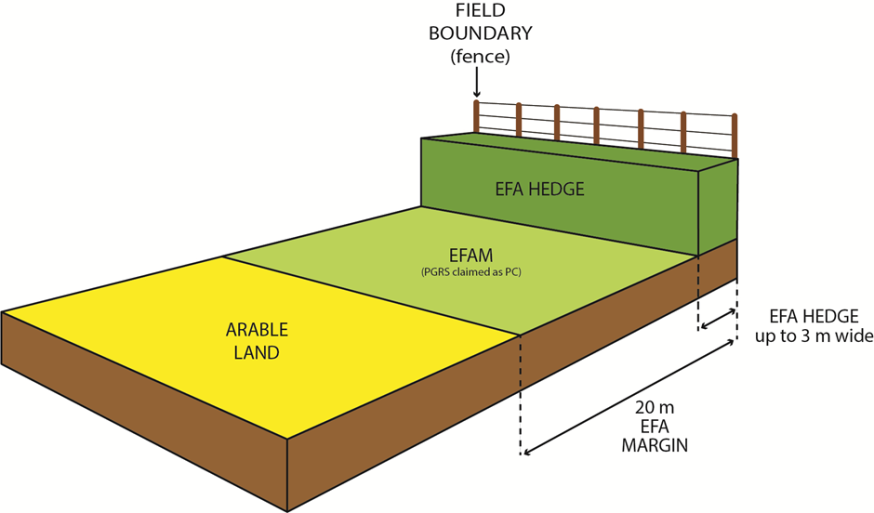
Diagram 2 below shows an EFA margin on permanent grassland (claimed as land use PC) within five metres of arable land.
In this example the road is less than five metres wide and the hedge may or may not be claimed as an EFA Hedge so can be included in the EFA margin area.
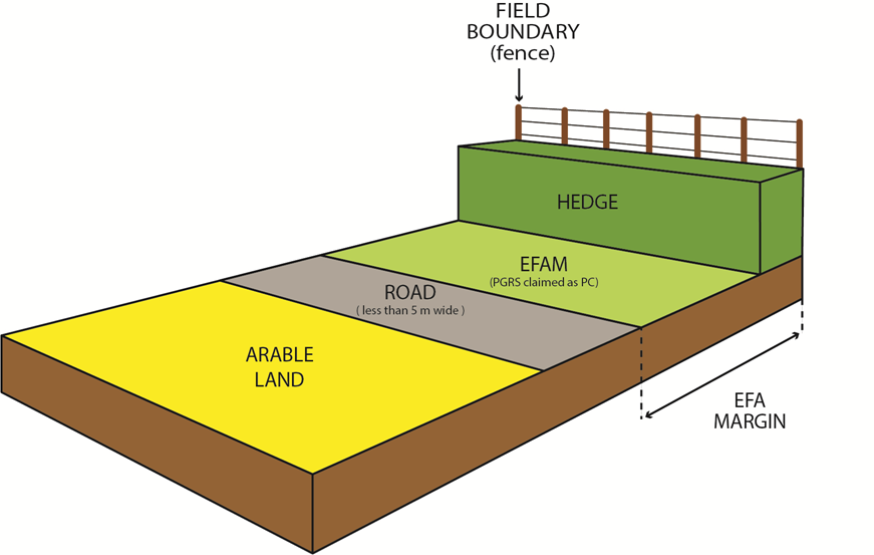
If you want to include areas in your EFA that are currently part of an agri-environment scheme you can do this. However:
- you must ensure that the management of the two schemes are compatible
- the payment you receive for your agri-environment scheme may be reduced to reflect the Greening payment you receive for your EFA feature
- there may be delays in the payment of your Basic Payment as both schemes will need to be validated
Agri-Environment Climate Scheme (AECS) participants
Businesses that hold AECS contracts and finds that their contract management obligations reduces their ability to deliver/meet their EFA requirements may apply to reduce one or more AECS commitments permanently to accommodate a broadly similar EFA requirement to the AECS option being reduced.
Please contact your local area office to discuss your proposed AECS reduction and EFA replacement in the first instance.
EFA mapping requirements
If you undertake any EFA on your holding, you no longer need to submit a map detailing the type, location and size of each EFA feature with your SAF. But you must retain an up-to-date copy of your EFA map for your business. These maps will be asked for at an inspection to help identify EFA locations.
The notes accompanying the map of EFA areas must include the following, where appropriate:
- LPID
- EFA option name
- area
- width and length
You only need to include plans of the field(s) with EFA options on them to meet your EFA map requirement.
If you have several parcels with EFA options on them, you can create individual maps if the parcels are some distance apart. This will allow for more detailed and clearer maps.
Your EFA map could be created by reusing your habitat audit map that you many have created for the new Whole Farm Plan audit requirements, by adding additional information to the habitat map as detailed above you can clearly identify your managed EFA options and utilise one map to meet both your requirements as long as it captures the information required for both schemes.
Map viewer
We introduced a new Map viewer in 2022 to improve the mapping data available. You can find further information on its functionality in the LPIS Guidance documents & tutorial videos.
With the introduction of the Map viewer we have introduced a new facility to create and submit EFA maps online.
An EFA feature which is an area that can be drawn on your EFA map using the EDIT EFAs layer on the External Viewer through the customer facing RP&S portal.
How do I draw an EFA area on my map?
The following diagrams show examples of EFA maps created using the new EFA area function.
EFA Fallow (EFAFAL)
1. The following diagram shows an example of an online map where the whole parcel is claimed as EFA Fallow - EFAFAL
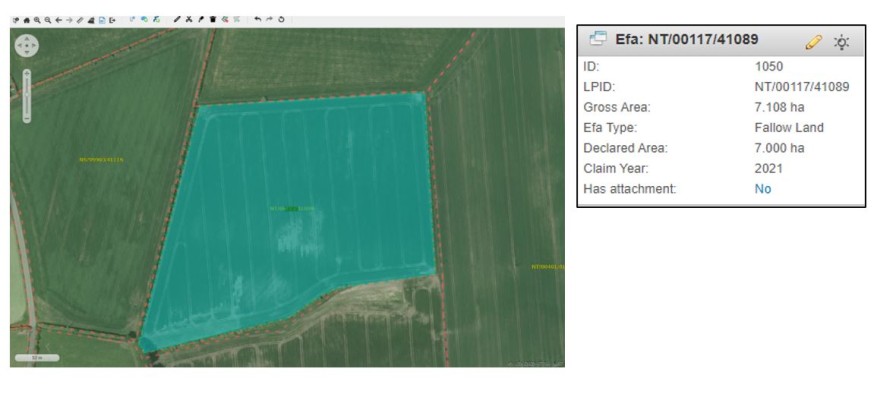
2. The following diagram shows an example of an EFA map showing in blue a claimed EFA margin created using the new EFA function within the Map viewer.

The details of the width of margin are in the Notes section.
3. This is an example of an EFA margin map submitted offline with a copy of an online version for comparison.
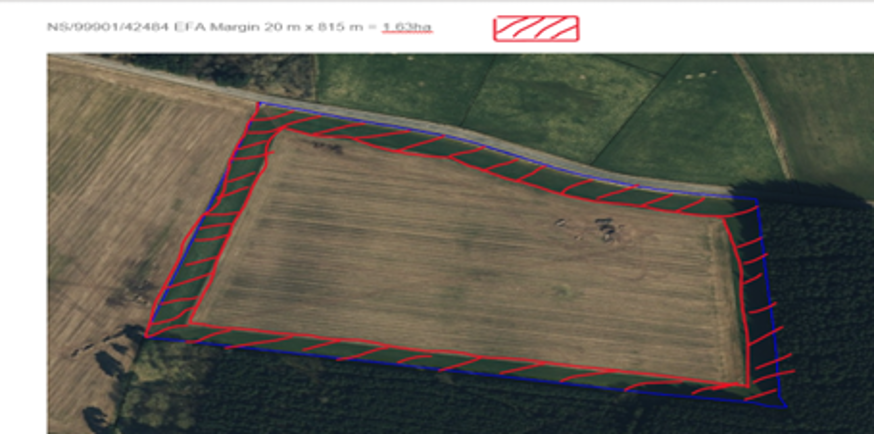
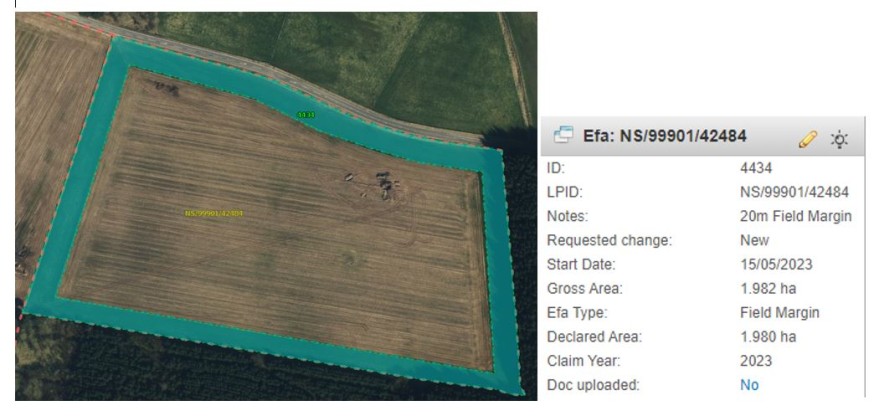
4. The following diagram shows an example of an online EFA map with two claimed EFA options: EFA Catch Crop (A) and Green Cover (B) (EFACC and EFAGC)
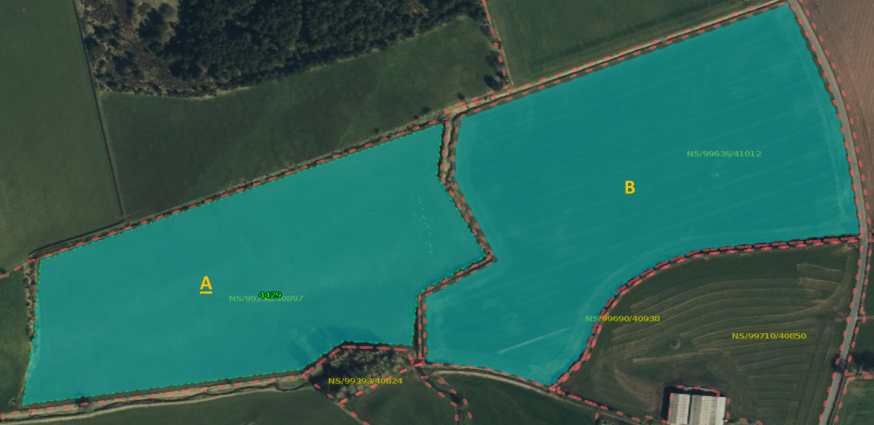
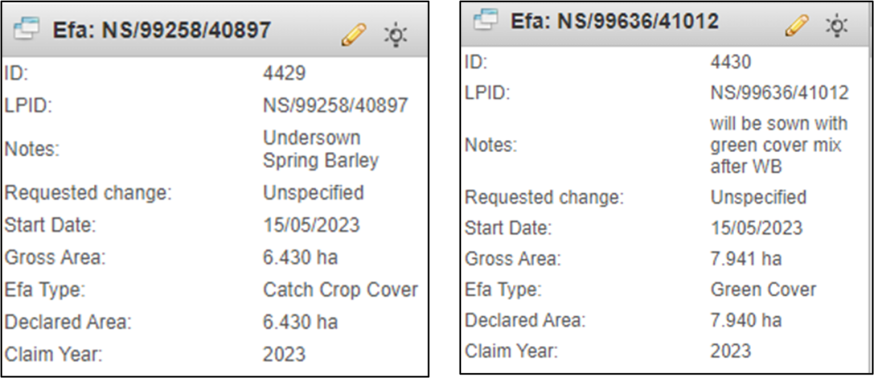
5. The following diagram is an example of a map showing EFA Nitrogen fixing crops (EFA-NFIX) surrounded by an EFA Margin (EFA-M)
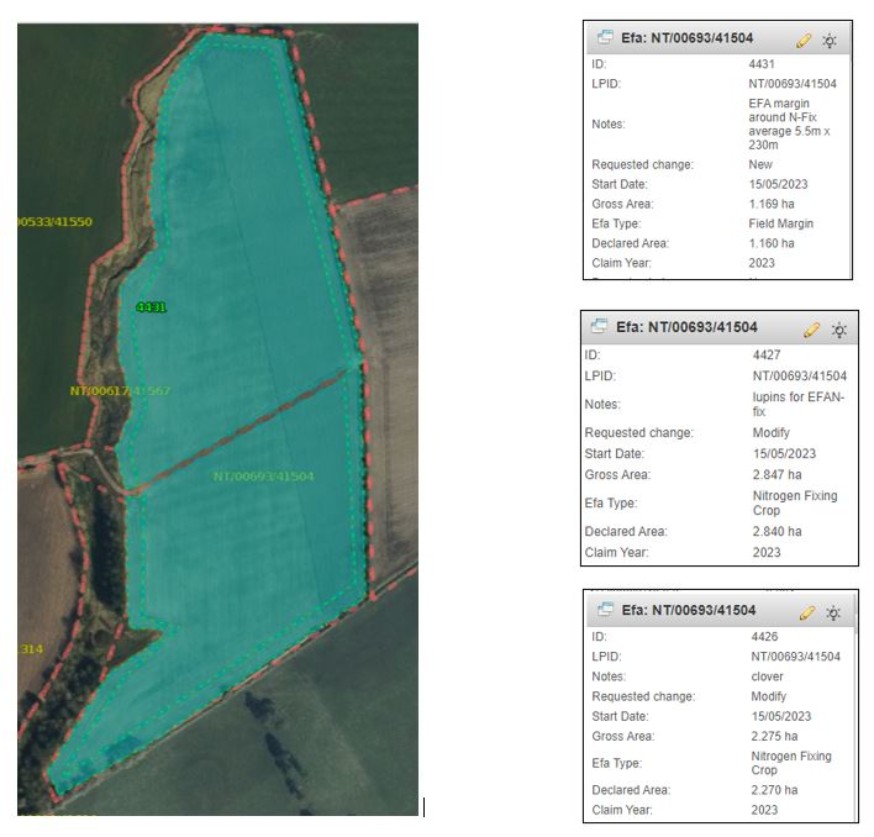
EFA fallow land (EFAFAL)
EFA Fallow land is arable land that has no crop production or grazing on it from 15 January to 15 July inclusive.
The ambition is to provide a biodiverse habitat that is beneficial for pollinators, birds, and soils.
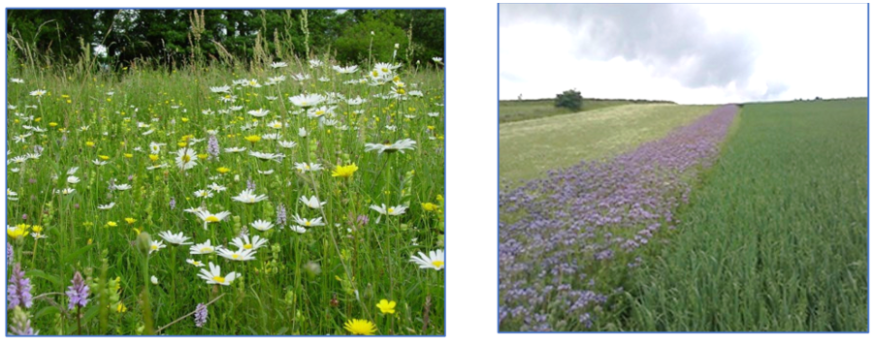
Above pictures: (left) EFA fallow – example of wild flower mix and (right) EFA fallow –example of soil conditioning crop (Phacelia)
Rule Changes for Enhanced Greening - EFA Fallow 2026:
You no longer have to submit an EFA map, but you must retain an up-to-date copy for your business. These maps will be asked for at an inspection to help identify EFA locations.
The ground cover from 15 January to 15 July inclusive must be either a diverse mix Temporary Grassland or Wild Flower Mix or a Wild Bird Seed mix or a Soil Conditioning crop. These covers can be established during the Fallow period.
Where you use Temporary Grassland (TGRS) for your fallow, it must have at least three flowering species.
If you intend to claim EFA Fallow on Machair Common Grazing you must only manage the fallow as natural regeneration from stubble.
Clarification: you must not apply herbicide before establishing a wild flower or wild bird seed mix.
What land is eligible to support EFA fallow?
Your land:
- must be arable land
- must be on your holding, on a claimed, Basic Payment Scheme eligible, agricultural parcel and claimed on your Single Application Form
- must have been in the preceding year fallow or an arable crop (including temporary grass, wild bird seed or wild flower mix)
- must be a minimum of 0.01 hectares in size
- must be clearly identifiable and distinguishable on the ground from 15 January to 15 July inclusive
Requirements for EFA fallow
You must:
- retain an EFA map relevant to your Single Application Form, detailing the location and size of your EFA Fallow land. See mapping requirements
- control injurious weeds, invasive weeds and other weed species by spot herbicide application or hand roguing (see details of GAEC in the Overview)
- the ground cover from 15 January to 15 July inclusive must be diverse mix Temporary Grassland or Wild Flower Mix or a Wild Bird Seed mix or a Soil Conditioning crop this can be established during the Fallow period if it is not created the year prior.
- where you use diverse mix Temporary Grassland (TGRS) for your fallow, it must have at least three flowering species – see table below for species
- where you use Wild Flower Mix Grassland it must be a mix, not stands of single species. Suitable species are shown in the table below
- where you use Wild Bird Seed Mix the mix must include at least two of the groups or species shown in the table below
- where you can sow stands of a single or mixed species of Soil Conditioning Crops from the list in the following table
- if you intend to manage EFA Fallow on Machair Common Grazing you must only manage the fallow following the traditional practice of leaving the land bare after cropping to allow natural reseeding of machair species
You must not:
- apply any plant protection products to the area of fallow from 15 January to 15 July inclusive, except by spot herbicide application for injurious weeds, invasive weeds and certain other weed species (refer to the Overview for guidance on GAEC requirements)
- undertake agricultural production between the dates of 15 January to 15 July inclusive. For example, this includes areas of land used in the establishment and growing of a crop
- store materials (including but not exclusively irrigation pipes, fuel bowsers, seed boxes, bales)
- use for the turning of machinery between the dates of 15 January to 15 July inclusive
- use for access (except for occasional use)
- undertake new drainage schemes in the period 15 January to 15 July (see flexibilities for maintenance of field drains below)
- change the land cover within the fallow period 15 January to 15 July inclusive with the exception of establishing diverse mix Temporary Grassland, Wild Flower Mix, Wild Bird Seed Mix, or a Soil Conditioning Mix as described in the table above
- apply herbicide before establishing a wild flower or wild bird seed mix.
- top the fallow between the dates of 15 January to 15 July inclusive
- apply any fertiliser, except to aid in the establishment of diverse mix Temporary Grassland, Wild Flower Mix, Wild Bird Seed Mix, or a Soil Conditioning Mix where you have sought advice from an agronomist or seed specialist, in the area of fallow from 15 January to 15 July inclusive
- cultivate the land and leave bare
You are allowed to:
- claim temporary grass as EFA Fallow if it has been declared as TGRS in no more than the five previous years (see below)
- change the ground cover to establish diverse mix TGRS, wild flower mix, wild bird seed mix, or a soil conditioning mix within the fallow area from 15 January to 15 July, if it has remained as stubble since harvest
- temporarily store farm yard manure for that field
- undertake maintenance of field drains in the period 15 January to 15 March, this is limited to investigation (inspection pits, etc.) and replacement of pipes or tiles where existing ‘bursts’ have been identified
- in exceptional cases (subject to prior approval) you may undertake maintenance of field drains in the period 15 March to 15 July. In such cases you must seek prior written approval from your local area office to undertake drainage which will only be approved if you can demonstrate that the works are essential and immediate (recently identified after heavy rain)
|
Enhanced Greening EFA Fallow |
|||
|---|---|---|---|
|
Temporary Grassland (TGRS) Must contain at least three flowering species such as: |
Wild Flower Mix Must be a mix not a stand/s of a single species - examples below |
Wild Bird Seed Mix Must include at least two from the choices below |
Soil Conditioning Crop Can be mixed or single stands |
|
bird’s-foot trefoil alsike clover balansa clover berseem clover crimson clover red clover sweet clover white clover knapweed lucerne vetch |
bird’s-foot trefoil alsike clover balansa clover berseem clover crimson clover red clover sweet clover white clover knapweed lucerne vetch black knapweed black medick red or white campion musk mallow ox-eye daisy ribwort plantain sainfoin selfheal sheep’s burnet sorrel wild carrot yarrow |
kale forage Rape swedes other brassicas linseed quinoa barley millet triticale wheat other cereal crops |
phacelia mustard chicory ribwort plantain |
| Year | 2020 | 2021 | 2022 | 2023 | 2024 | 2025 | 2026 |
|---|---|---|---|---|---|---|---|
| Land use | SB | TGRS1 | TGRS2 | TGRS3 | TGRS4 | TGRS5 | FALW |
| EFA option | 0 | 0 | 0 | 0 | 0 | EFAFAL | EFAFAL |
|
Best practice for EFA fallow land • if you choose to put temporary grass in fallow the land retains its arable status for the period it is claimed as EFA Fallow even if the grass is more than five years old • if you’ve claimed temporary grass as EFA Fallow in one year and decide not to claim this as EFA Fallow in the following year, it will revert to being temporary grass if it’s five years or younger, or permanent grass if it’s older than five years • you may be asked to provide a seed label if one element of your wild bird seed mix or wild flower mix or soil conditioning mix fails, to prove eligibility • if weed control is a problem, then you may consider establishing a wild flower mix or wild bird seed mix to aid weed control. See the overview for guidance on GAEC requirement • flowering species can be difficult to over sow into existing swards. They may need to be sown in the year prior to claiming it as EFA Fallow • if you have established Wild flower or Wild Bird Seed mixes these can be left in situ till the end of the year or longer in the case of Wild Bird Seed, or be allowed to self-seed for the following year in the case of Wild Flower Mix • consider Ground nesting birds before carrying out cultivations to establish Wild Bird Seed or Wild Flower Mix; It may be better to establish the cover in the Autumn of the preceding year. If you do have to carry out cultivations in the Spring nest should be avoided • it may be useful to get advice from a FACTS qualified adviser. They can advise on the benefits of correcting soil nutrient deficiencies both for establishment of Wild Bird Seed mixes and to ensure livestock health where grazing or feeding of harvested forage takes place after 15 July • Soil Conditioning Crops don’t have to be destroyed promptly after 15 July. Keeping them for longer builds more plant mass above and below ground, increasing organic matter • if you intend to destroy the cover in mid-July, then use mixes with earlier flowering species to maximise the benefits to wildlife • sowing rates for Wild Flower Mix / Wild Bird Seed / Soil Conditioning Crops can be advised by agronomists or from the seed suppliers • it can be beneficial for biodiversity to retain fallow for more than one year to encourage both annual and perennial plants • stagger mowing to create a diversity of successional stages and to avoid seasonal gaps of plants in flower |
EFA margins (EFAM)
Margins provide an important habitat for farmland biodiversity, contribute to wildlife and ecological networks and benefit water quality. Margins must remain in place from 1 January to 31 December inclusive.
Conservation headlands, beetlebanks and grass margins, and watercourse margins around arable fields are a valuable feature for farmland biodiversity but also support sustainable food production. They support crop pollinators and pests’ natural enemies helping deliver Integrated Pest Management, and function as a refuge after harvest. When adjacent to watercourses they act as a buffer preventing nutrient leaching, soil erosion and diffuse pollution.

Pictures above: (left) EFA Margin between 3 metres and 20 metres wide between two crops. (right) A 3 metres wide EFA Margin next to an EFA Hedge.
Rule Changes for Enhanced Greening – EFA Margins 2026:
You no longer have to submit an EFA map, but you must retain an up-to-date copy for your business. These maps will be asked for at an inspection to help identify EFA locations.
We have increased the minimum field margin size to 3 metres wide from 1 metre to increase the biodiversity benefit.
Where a new margin comprising a grass sward is being created it must be a diverse grass sward containing pollen bearing plants, examples of these can be found within the best practice section of this document.
What land is eligible to support EFA margins?
Your land:
- must be; on, adjacent to, or within five metres of arable land or contiguous to a claimed EFA option
- can be around the margin of a field or splitting two crops within a field
- must be on your holding, on a parcel that is Basic Payment Scheme eligible and claimed on your Single Application Form
- must be between 3 and 20 metres wide
- must be a minimum of 0.01 hectares in size
- must be clearly identifiable and distinguishable on the ground from 1 January to 31 December, inclusive
Requirements for EFA margins
You must:
- retain an EFA map relevant to your Single Application Form, detailing the location and size of your EFA margins. See mapping requirements
- control injurious weeds and invasive weeds. This must be only done by spot herbicide application or hand rogueing. Other weed types may be treated by permission but again this must be only done by spot herbicide application or hand rogueing
- not breach Cross Compliance requirements – refer to the Overview for guidance on Cross Compliance requirements
- you must retain the seed label as evidence of attempted establishment of the margin so that in the event of crop failure you have evidence of the attempt to establish
You must not:
- graze or cut the margin before and including 15 July
- apply any plant protection products to the area of margin from 1 January to 31 December inclusive, except by spot herbicide application for injurious weeds, invasive weeds and other weed species (refer to the Overview for guidance on Cross Compliance requirements)
- apply any fertiliser with the exception that you may apply fertiliser to aid the establishment of a wild bird seed mix
- clean ditches and spread the spoil on any area which has been claimed as an EFA margin
- graze the margin if it contains or is adjacent to a watercourse to avoid diffuse pollution
- store materials - including but not exclusively irrigation pipes, fuel bowsers, seed boxes, bales
- use for regular access (except for occasional use including for hay and silage making)
You are allowed to:
- change the cover to establish a wildflower mix, wild bird seed mix or a diverse grass sward containing pollen bearing plants – remember the GAEC 1 and 7 rules regarding 2 metre buffer strips. Further information can be found on the GAEC 1 page
- apply fertiliser to aid establishment of wild bird seed mix
- cut after 15 July including for silage or hay
- graze after 15 July, if the margin does not contain or is not adjacent to a watercourse
|
Best practice for EFA margins • hedges and ditches defined as eligible landscape features (hedges up to three metres wide and ditches up to two metres wide), may be included as part of an EFA margin • if you have existing beetle banks created under a previous agri-environment scheme this can be included in an EFA margin. However this may result in potential double funding and a reduction in your agri-environment payment • if land was sown out as temporary grassland a number of years previously and is now permanent grassland (i.e. more than five years old), the area is still eligible for an EFA Margin if it is adjacent or within five metres of arable land • if the area of the EFA margin includes land ineligible for your Basic Payment this must be deducted from the area of the EFA Margin claimed • any permanent grassland claimed as an EFA Margin is considered as ‘arable’ for the purposes of the Greening calculation (EFA area) and should be claimed as Permanent Cover (PC) on your Single Application Form • if the EFA margin splits two crops these can be the same crop (such as a field of winter barley split in two by an EFA Margin) • you can increase the benefit of the EFA Margins by making them wider than six metres. Margins near or adjacent to water could be used to manage for irregular flood alleviation |
Additional Advice for EFA Margins
- species selection for new margins should take account of location, soil, the adjacent crop, and the planned lifespan of the margin. For example, ideal species composition for short term margins around potato and vegetable headlands will differ from long term margins that you plan to retain over a number of years
- you should also take into account pollen-bearing plants may not compete very well with sown rye grasses in establishment
- margin function is another important consideration for seeding mix, whether you want to attract pests’ natural enemies such as hoverflies, ladybirds or parasitic wasps with pollen and nectar to fight aphids or attract and retain ground beetles with tussocky grasses to help fight slugs. Local pest and disease pressures should also be considered when choosing species to avoid creating reservoirs for ergot, clubroot, or slugs. To encourage pollinators, consider a range of flower species with different shapes and different flowering times
- if you are creating a new margin that you are planning to retain for a longer term, mowing or grazing in the first year is important to help perennial species establish and avoid annual weeds becoming dominant
- the list below can be used as an initial guide to species selection, with further advice being available from seed merchants and agronomists
|
Enhanced Greening EFA Margin |
||
|---|---|---|
|
Short term annual Diverse Grass Sward suitable species |
Longer term Diverse Grass Sward suitable species |
Wild Bird Mix suitable species |
|
Flowering plants: Buckwheat Poppy Borage Calendula Corn Cockle Cornflower Corn Marigold Corn Chamomile Scentless Mayweed Legumes: Vetch Balansa clover Berseem Clover Crimson Clover Black Medick Low productivity grasses: Timothy Fescue Cocksfoot |
Flowering plants: Yarrow Oxeye Daisy Musk Mallow Red Campion White Campion Lady’s Bedstraw Knapweed Wild Carrot Sheep’s Parsley Common Hogweed Chicory Legumes: White Clover Red Clover Sainfoin Birdsfoot Trefoil Low productivity grasses: Timothy Fescue Cocksfoot |
Wheat Oats Barley Rye Triticale Linseed Radish Rape Mustard Kale Quinoa Millet Sunflower Buckwheat |
- locating Margins next to water courses or combined with hedges and woodland edges delivers greater benefits for the farm and its biodiversity
- for Integrated Pest Management, margins placed in a sunny location and upwind of the main crop help to retain and disperse more natural enemies. Species choice is important too, because many natural enemies can’t easily feed on deep flowered species like clover or vetch
- staggering mowing of areas in the margin will help to avoid removing all flower resources and shelter at the same time
- avoid spraying and fertilising within 2 metres of the margin to reduce damage to plant and invertebrate diversity, both above and below ground
- increasing the width of a margin from 3 metres to 6 metres will increase benefits and reduce any negative impacts of the adjacent field management, especially pesticides and fertiliser drift
Useful Links:
Further advice on the benefits and management of margins
SRUC - Harnessing the Power of Nature: Arable Edges and Hedges report
Examples of EFA margins
The following illustrations provide examples of EFA Margins. Please note – these are indicative examples to help you when considering your EFA requirements. If you are unsure if your chosen area is eligible to count towards an EFA Margin, please contact your local Area Office with details and they will provide further guidance.
Example one – EFA margin in an arable field
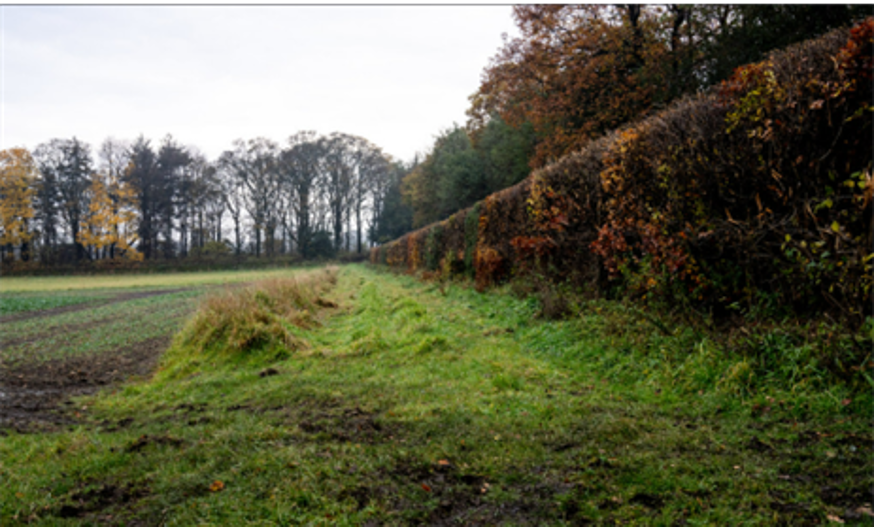
Above is an existing grass margin (possibly a former agri-environment option or a margin established in grass) running from the centre of the hedge to the edge of an arable crop. The EFA Margin should be between 3 and 20 metres wide on arable land, in this example it is 5 metres wide from the crop to the centre of the hedge.
Example two – EFA Margin adjacent to hedge including GAEC strip and Basic Payment Scheme eligible landscape feature
In the example below an EFA Margin has been claimed and is EFA eligible as it is adjacent to arable land. The EFA Margin is between 3 and 20 metres wide and is claimed as Permanent Cover (PC) as it is on permanent grassland.
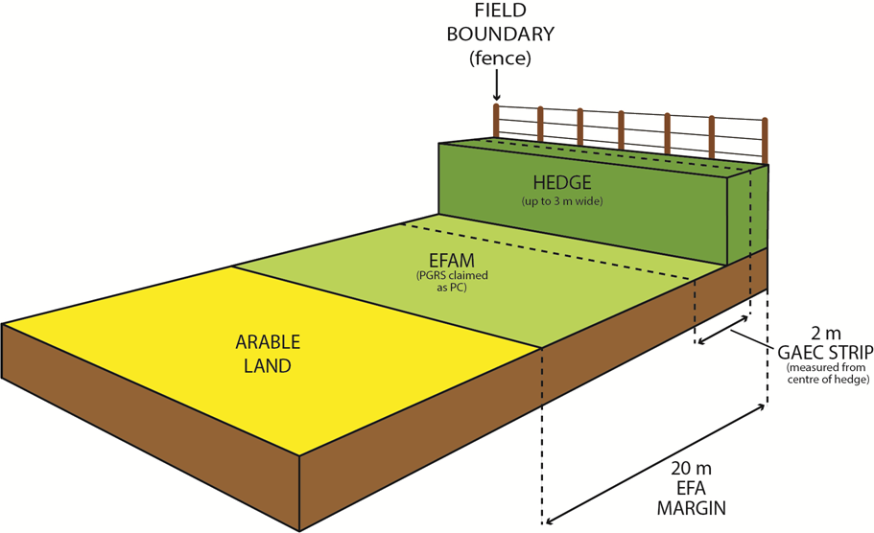
To be aware:
In this instance, there is a Cross Compliance requirement to maintain a two metre wide, uncultivated strip from the centre line of the hedge.
Example three – margin and hedge both claimed as EFA
The example below shows the hedge is eligible to be claimed as an EFA hedge as it is contiguous to the EFA margin (see guidance on Where can I put my EFA).
In this example the hedge is being claimed for EFA, noting any hedge up to three metres wide is eligible as an EFA hedge.
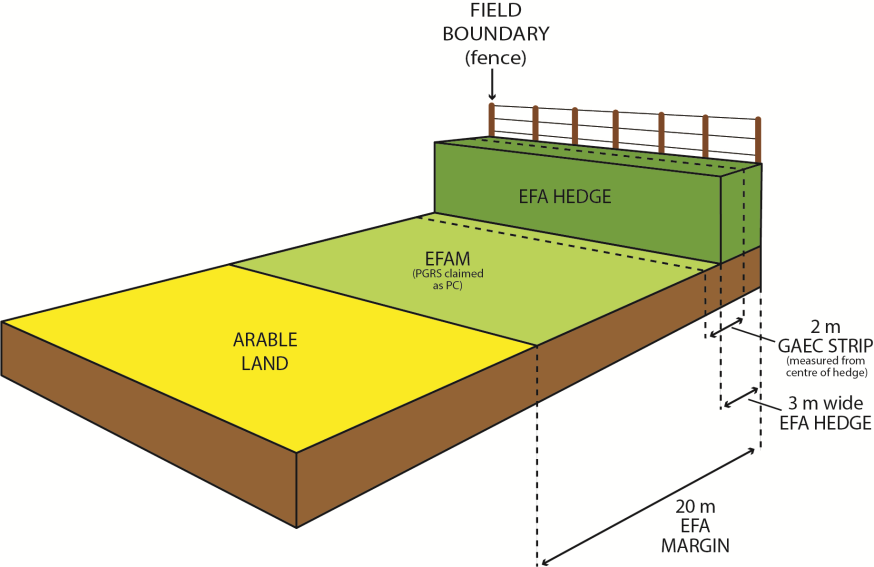
Example four – BPS eligible landscape feature included within the EFA margin
In the example below, the farmer has chosen to include an area from the fence to the edge of the cropped arable land.
This includes, as part of the EFA margin, the water feature as it is less than two metres wide (a Basic Payment Scheme eligible landscape feature) and the two metre wide, uncultivated GAEC strip for the water feature.
The two metre wide GAEC strip starts at the top of the bank (not from the water’s edge). Refer to the Overview for guidance on GAEC requirements.
This permanent grassland, if claimed as an EFA margin, is considered as ‘arable’ for the purposes of the Greening calculation and should be claimed as Permanent Cover (PC) on your Single Application Form.
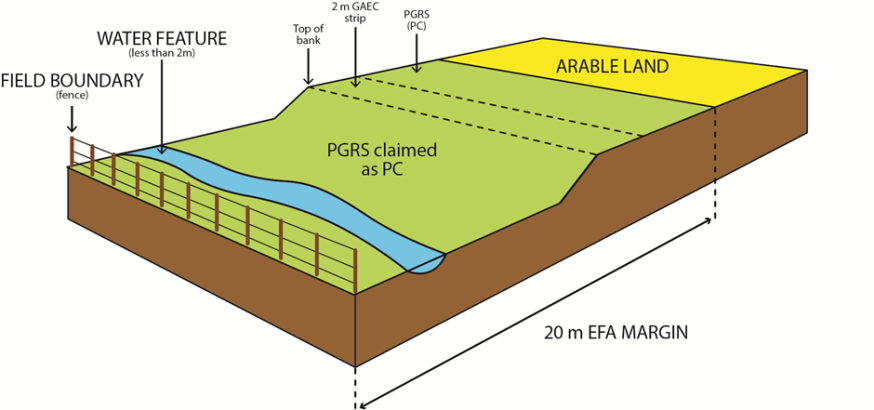
Example for implementing the five metre adjacent rule for an EFA margin
Example 5 - claimed EFAM within five metres of arable land, note the watercourse is an ineligible landscape feature and must be deducted from the EFA margin.
In the example below a parcel of arable land has a three metre road on its boundary. The applicant wishes to claim an EFAM on an adjacent parcel using the five metre adjacent rule.
- Where do I start measuring the EFA margin from?
We would start measuring from the fence as the eligible land cover is within five metres of the arable land.
This width would be restricted to a maximum of 20 metres from this point. Any ineligible features found within this area would be excluded from the found area.
In this example, the EFAM claimed area is 20 metres wide however, as the watercourse is three metres wide (which makes it ineligible for BPS), it’s area will need to be deducted from the overall area of EFAM to establish a net eligible area of EFA.
As the Permanent Grass (PGRS) is within five metres of arable land, we would claim this EFA supporting land cover as Permanent Cover (PC) and we would not include the road in the EFAM area.
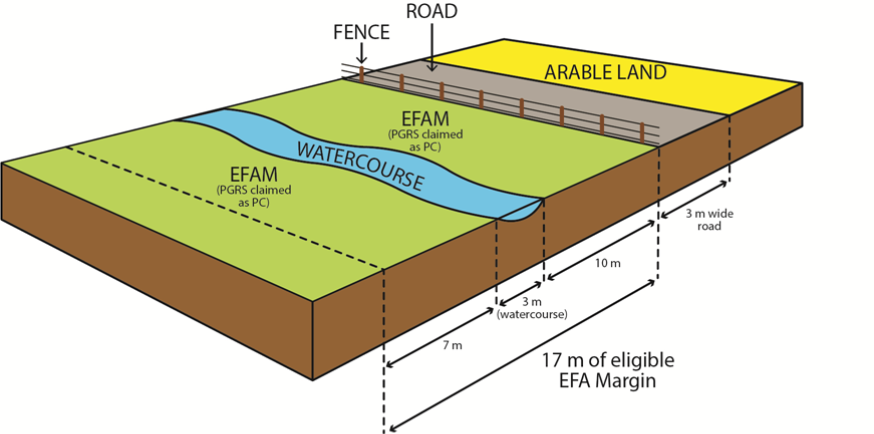
EFA catch crop (EFACC)
In Scotland, catch crops will be: a Cereal Crop under-sown with a legume or a diverse grass mix; or Oilseed Rape under-sown with a mix such as berseem clover and red clover as the catch crop; or Maize under-sown with a diverse grass mix, or Beans sown in conjunction with Barley or Wheat.
A catch crop can provide an enhancement to biodiversity, improve soil health, provide Nitrogen fixing, and prevent soil erosion and nutrient leaching along with protecting water courses.
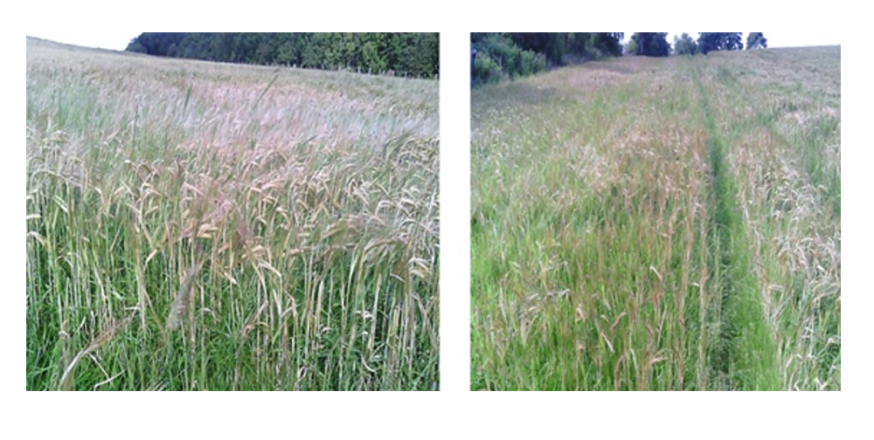
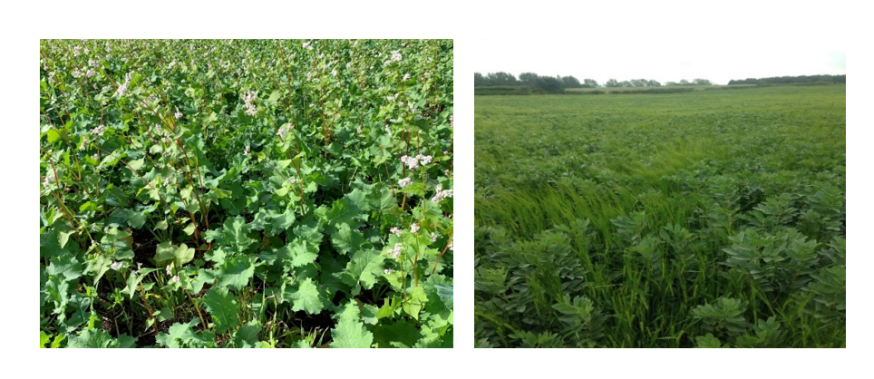
Pictures above: EFA catch crop – barley under-sown with grass
Rule Changes for Enhanced Greening – EFA Catch Crop 2026:
You no longer have to submit an EFA map, but you must retain an up-to-date copy for your business. These maps will be asked for at an inspection to help identify EFA locations.
The number of crop types that can be under-sown has been expanded to include oilseed rape and maize, not just cereals. Beans can be sown in a mix with Cereals.
You can now control injurious weeds and invasive weeds with herbicide post-harvest (refer to the Overview for guidance on Cross Compliance requirements).
What land is eligible to support EFA catch crop?
Your land:
- must be arable land
- must be on your holding, on a claimed Basic Payment Scheme eligible agricultural parcel, and claimed on your Single Application Form
- must be a minimum of 0.01 hectares in size
- must be clearly identifiable and distinguishable on the ground
- must be a cereal, oilseed rape, or maize crop
Requirements for EFA catch crop
You must:
- retain an EFA map relevant to your Single Application Form, detailing the location and size of your EFA Catch Crop. See mapping requirements
- under-sow the main crop
- maintain the EFA Catch Crop up to 31 December inclusive
You must not:
- use plant protection products from the date of harvest of the main crop to 31 December inclusive except for injurious weeds and invasive weeds (refer to the Overview for guidance on Cross Compliance requirements)
You are allowed to:
- graze the EFA catch crop after harvest of the main crop
|
Best practice for EFA catch crop • Arable Silage for Stock Feed (ASSF) is not eligible for EFA Catch Crop, as it is not a main crop as defined in the Regulations, (Spring Barley for example is a main crop type) this does not mean you cannot take the crop as an arable silage / whole crop. It must not be claimed for LFASS • retain the seed label; you may be asked to provide this to prove eligibility if your EFA Catch Crop fails • using a diverse mix of grass and legumes (such as clover) will increase soil health, produce biodiversity benefits and can reduce soil inputs • while on most occasions you will know what is the appropriate mix to sow under your crops that suit your location, you may wish to seek advice from a qualified adviser regarding species mix, or to help confirm the benefits of correcting soil nutrient deficiencies both for crop establishment and to ensure livestock health where grazing or feeding of harvested forage takes place, after harvest of main crop • mixtures of the species listed could be used to create a living mulch to help provide Nitrogen for the companion or following crops • under sowing OSR may need a mix of clovers to ensure persistence to the end of December in the year of harvest. This means the catch crop can be grazed / topped / direct drilled through with the following crop |
|
Enhanced Greening EFA Catch Crop |
|
|---|---|
|
Flowering Species suitable species |
Grass Species suitable species |
|
alsike clover balansa clover berseem clover bird’s-foot trefoil crimson clover lucerne red clover sweet clover white clover vetch knapweed other species Beans |
Italian rye grass perennial rye grass bent grass chewings/red fescue meadow fescue sheep’s fescue smooth-stalked meadow grass timothy |
Useful Links:
An introduction to cover crops provides useful information on the management and potential benefits for catch crops
EFA green cover (EFAGC)
Green cover is the establishment of a temporary crop in the autumn that will provide an enhancement to biodiversity, improve soil structure and fertility, will prevent soil erosion and nutrient leaching, and may be grazed.
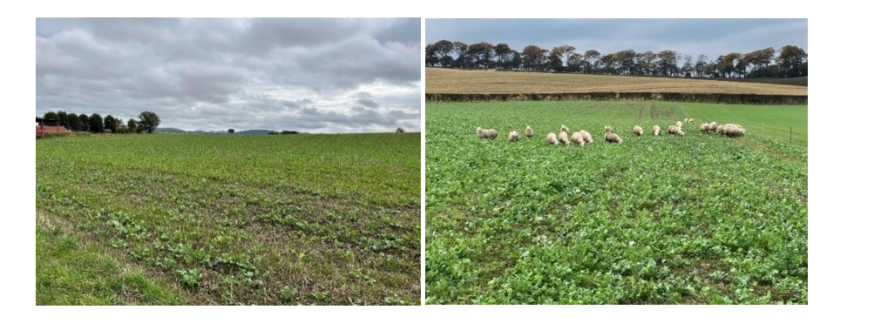
Rule Changes for Enhanced Greening – EFA Green Cover 2026:
- you no longer have to submit an EFA map, but you must retain an up-to-date copy for your business. These maps will be asked for at an inspection to help identify EFA locations
- we have increased the number of species that can be included in cover crop mix. Including alsike clover, balansa clover, crimson clover, persian clover, buckwheat, kale, stubble turnip, forage rape, beans
- we have removed the restriction on grazing before 31 December
- we have added these sentences in helpful tips: If you are in any doubt about your ability to establish the Cover crop by 1 November you should choose another EFA option
What land is eligible to support EFA green cover?
Your land:
- must be arable land
- must be on your holding, on a claimed Basic Payment Scheme eligible agricultural parcel, and claimed on your Single Application Form
- must be a minimum of 0.01 hectares in size
- must be clearly identifiable and distinguishable on the ground
Requirements for EFA green cover
You must:
- retain an EFA map relevant to your Single Application Form, detailing the location and size of your EFA cover crop. See mapping requirements
- establish the EFA green cover by 1 November
- maintain the EFA Green Cover up to the 31 December inclusive. (However it can be retained for longer to maintain the benefits to the soil)
- establish a green cover consisting of two or more of the following crops as the predominant crops: alfalfa, barley, alsike clover, balansa clover, crimson clover, red clover, persian clover, white clover, buckwheat (can cause skin Photosensitisation), mustard, oats, phacelia, radish, rye, triticale, vetch, kale, forage rape, stubble turnip, beans
You must not:
- use plant protection products from establishment of the EFA Green Cover until the 31 December
- incorporate and sow any green cover to a winter crop in the autumn (prior to 31 December) of the year that it is claimed as an EFA
- take to harvest any crop sown as EFA green cover
|
Helpful tips for EFA green cover • you may be asked to provide a seed label to prove eligibility, if one element of your EFA green cover fails • if you intend to sow your EFA green cover immediately after harvesting another crop, you must remember you are required to establish it by 1 November. If you are in any doubt about your ability to establish the crop by 1 November you should choose another EFA option • cover crops can be broadcast into standing crops, prior to harvest • grazing or incorporating the cover can provide different benefits in terms of fertilization of soil from manure, or leaving for mulch, and/or root depth to put organic matter into soil |
EFA nitrogen-fixing crops (EFA-NFIX)
Nitrogen-fixing crops are plants that contain symbiotic bacteria called Rhizobia within the nodules of their root systems, producing nitrogen compounds that help the plant to grow and compete with other plants.
When the plant dies, the fixed nitrogen is released making it available to other plants and this helps to fertilise the soil.
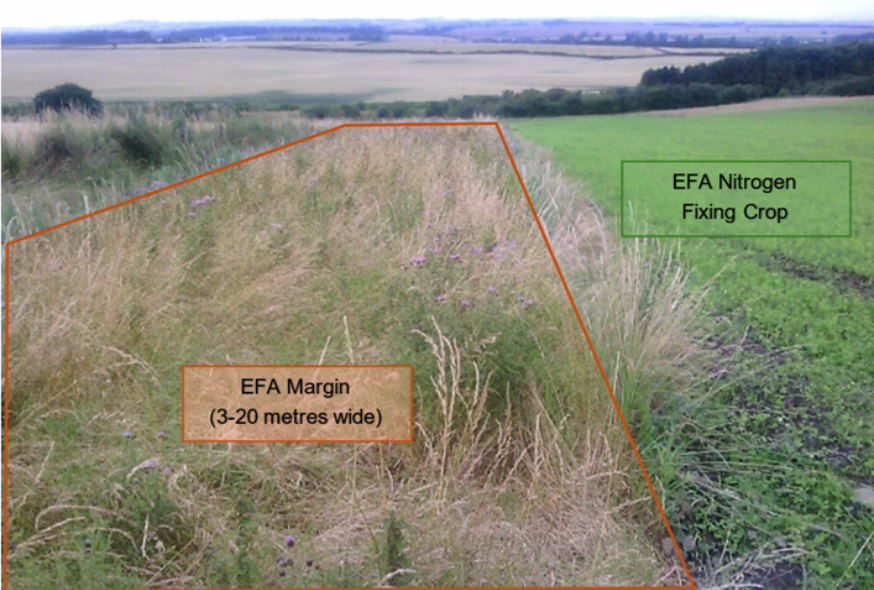
The picture shows an EFA Nitrogen-Fixing crop with an associated claimed EFA margin.
Rule Changes for Enhanced Greening - EFA Nitrogen-Fixing Crops 2026:
You no longer have to submit an EFA map, but you must retain an up to date copy for your business. These maps will be asked for at an inspection to help identify EFA locations.
We have increased the number of eligible crops to include:
- alsike clover
- balansa clover
- berseem clover
- red clover
- sweet clover
- fenugreek
We have removed the requirement that prevented the crop being harvested before 1 August.
You are now allowed to apply herbicide to control grass weeds, and you are now allowed to apply Fungicide.
We have added a best practice section.
What land is eligible to support EFA nitrogen-fixing crops?
Your land:
- must be arable land
- must be on your holding, on a claimed Basic Payment Scheme eligible agricultural parcel, and claimed on your Single Application Form
- must be a minimum of 0.01 hectares in size
- must be clearly identifiable and distinguishable on the ground
Requirements for EFA nitrogen-fixing crops
You must:
- claim a minimum of two separate Nitrogen Fixing Crops (single stands or mixes). This should also be distinctly separate areas. This benefits bees and insects by having a minimum of two different flowering periods
- ensure they are different crop types
- if you wish to use a mix of legumes as a nitrogen fixing crop this will only count as one crop and you will still need another single stand or mix
- ensure where you use seed mixes as nitrogen-fixing crop there are different legume species as predominant by weight of seed for each crop. This is so they can be identified at inspection, either visually or from the seed label as a minimum of two separate Nitrogen Fixing Crops. For example only; red clover white clover mix, you could have one crop 60% Red clover 40% white, and the second crop 51% white clover 10% red clover 39% perennial ryegrass
- the predominant nitrogen-fixing crop (for each claimed EFA Nitrogen-Fixing Crop area) should be declared as the Land use on your Single Application Form and enter the EFA code in the Activity column and the area in the Unit column.
- ensure that the main EFA claimed nitrogen-fixing crop is less than or equal to 75% of the total area of EFA claimed as nitrogen-fixing crops
- ensure that areas claimed as EFA Nitrogen-Fixing Crops are surrounded by a claimed EFA Margin. The margin must meet the updated guidance for 2026 EFA Margin rules, including retention and management until 31 December inclusive
- retain an EFA map relevant to your Single Application Form, detailing the location and size of your EFA Nitrogen-Fixing Crops. See mapping requirements
|
Enhanced Greening EFA Nitrogen-Fixing Crops |
|---|
| At least two from the list below |
|
alfalfa beans (including Faba beans) birdsfoot trefoil chickpea alsike clover balansa clover berseem clover red clover sweet clover white clover fenugreek lentil lupin peas vetch |
You must not:
- use insecticide as they are prohibited on all areas of EFA Nitrogen-Fixing Crops from establishment until after harvest of the nitrogen-fixing crop
You are allowed to:
- apply herbicide to control grass weeds, and fungicide, following advice from an Agronomist
|
Best practice for EFA nitrogen-fixing crops • the associated EFA Margin must be managed in accordance with the EFA Margin guidance. Therefore if you wish to graze the aftermath of the EFA Nitrogen-Fixing Crop measures must be put in place to exclude livestock from any EFA Margins adjacent to watercourses • growing a nitrogen-fixing crop such as clover or vetches could bring significant benefits for pollinators when compared with peas which self-pollinate • you may wish to seek advice from a qualified adviser regarding species mix, or to help confirm the benefits of correcting soil nutrient deficiencies both for establishment and following crops, or livestock health if grazed or forage harvested • the James Hutton Institute has completed a project on intercropping which provides useful information and potential benefits from the management practice |
Examples: the diagram below shows examples of an EFA Margin surrounding EFA Nitrogen-Fixing Crops.
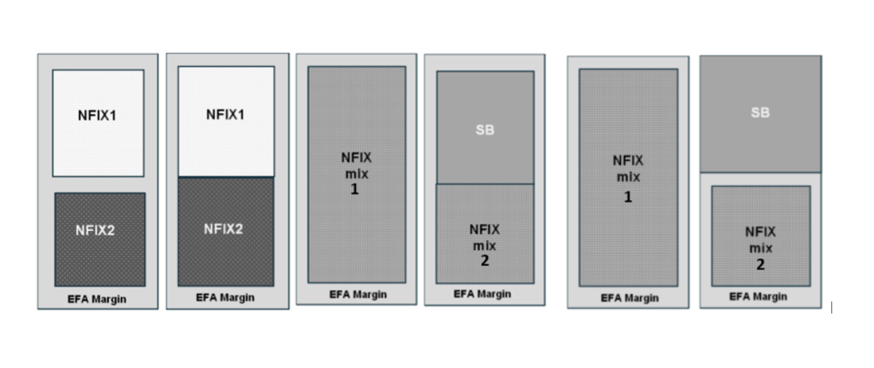
EFA hedges (EFAH)
Hedges provide a habitat and wildlife corridor for a variety of farmland birds, insects and mammals.
They increase farmland biodiversity and also protect arable crops from the wind, thereby reducing soil erosion and resulting pollution, or provide shelter for livestock welfare benefit on permanent pasture, and where forage crops are in an arable rotation.
The aim is to produce a hedge that is diverse and has a bushy structure so has plenty of nesting areas, flowers for pollinators, and berries for birds to feed on from late Autumn onwards.
What is an EFA hedge?
An EFA Hedge is:
- any hedge having a length of at least 20 metres
- any gap of less than 5 metres is treated as being part of the hedge
- a GAEC landscape feature and as such has no land cover and is fully eligible for BPS where it’s 3 metres wide or less in any one field
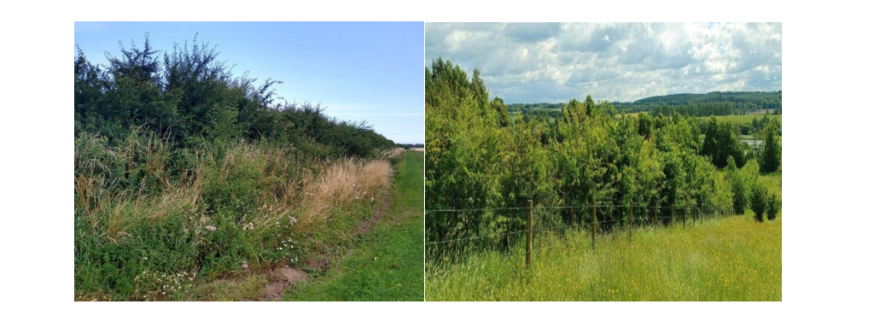
Changes for Enhanced Greening 2026:
- you no longer have to submit an EFA map, you just have to retain an up to date copy for your business. These maps will be asked for at an Inspection to help identify their location
- definition of a hedge has changed: previously any gap of up to 20 metres counted as part of the hedge. This has been reduced to 5 metres to encourage replanting (excluding gateways)
- the dates for hedge trimming have changed. Previously you could not trim hedges or lop branches off trees during the bird nesting and rearing season starting on 1 March and ending 31 August except for road safety. This window has been extended so you cannot trim hedges or lop branches off trees during the bird nesting and rearing season starting on 1 March and ending on the 1 December except for road safety reasons, or when establishing a Winter Oilseed Rape crop or Temporary Grass. (you still need written permission of the Scottish ministers from RPID to trim the EFA managed hedges to establish other winter crops between 1 August and 31 August). Best practice is to team a hedge with a margin to mitigate the need to trim hedges when establishing Winter crop
- added a recommendation that you should not cut any more than one third of the length of your hedges managed under this Enhanced EFA option
- added recommendations to manage in conjunction with a margin where possible
- added recommendations on best practice trimming
What land is eligible to support an EFA Hedge?
Your hedge:
- must be on or within five metres of arable land or contiguous to a claimed EFA option in such a way that the longest edge of the hedge is parallel to the field
- must be on your holding, or under your control/responsibility, on a claimed or adjacent to a claimed parcel (see example one below ), that is BPS eligible and claimed on your SAF
- can be any height but must be up to and including three metres wide from the centre of the hedge (hedges wider than three metres from the centre of the hedge are BPS and EFA ineligible)
How much does my EFA Hedge contribute to my EFA requirement?
- an EFA Hedge is a linear feature. Each linear metre is worth 10 metres squared of EFA contribution if claimed in its entirety
- if the EFA Hedge forms a boundary between two parcels, the hedge in each parcel will count as 5 metres squared (50%) of EFA contribution
Requirements for EFA Hedges
You must:
- if you want to claim a newly planted hedge as an EFA Hedge it must have been established before the BPS application is submitted (prior to 15 May)
- retain an EFA map relevant to your Single Application Form, detailing the location and length of your EFA Hedge. See mapping requirements
- manage EFA Hedges in accordance with Cross Compliance (GAEC 7 – Retention of landscape features) - cross compliance guidance apart from the trimming dates
You must not:
- remove or destroy hedges without the written consent of the Scottish Ministers
- trim hedges or lop branches off trees during the bird nesting and rearing season starting on 1 March and ending on 1 December except for road safety reasons, or when establishing a winter oilseed rape or Temporary grass. Hedge laying can be carried out up to and including 31 March
- cultivate land within two metres of the centre line of a hedge unless one of the following exemptions apply:
- cultivating to establish a green cover where one doesn’t already exist. A green cover excludes crops that are grown for a commercial purpose, e.g. arable crops including crops that are under sown with grass
- cultivating to establish a new hedge
- apply fertilisers (organic manure, chemical or nitrogen) or pesticides within two metres of the centre line of a hedge unless one of the following exemptions apply:
- applications of fertilisers or pesticides to establish a new hedge. This applies from the time the land is prepared for planting the new hedge to the end of the hedge’s third growing season
- spot application of pesticides to control injurious weeds, invasive species and, after prior written consent of the Scottish Ministers and/or other statutory bodies, certain other weed species
Helpful tips for EFA hedges
- hedges can include gaps, provided that no individual gap (not including gateways) is greater than 5 metres
- if a hedge contains any individual trees then they are considered as part of the hedge
- if the hedge is a boundary between two fields half the hedge should be claimed against each field
- if you want to include areas in your EFA that are currently part of an agri-environment scheme you can do this. However:
- you must ensure that the management of the two schemes are compatible
- the payment you receive for your agri-environment scheme may be reduced to reflect the Greening payment you receive for your EFA feature
- there may be delays in the payment of your Basic Payment as both schemes will need to be validated
- you should not cut any more than one third of the length of your hedges managed under this option. Less hedge cutting helps with the reduced timescale for hedge management.
- Manage in conjunction with an EFA Margin to allow easier access for hedge cutting, and creating a mutually beneficial habitat.
- September/October cutting will score “poor” in a biodiversity audit. November/December trimming will score moderate. Nature Scot advise January/February trimming provides a good habitat score. This allows the maintenance of resources and shelter for as long as possible while respecting GAEC rules
How do I claim an EFA hedge?
Example one – EFA hedge adjacent to the boundary of a BPS claimed field
In this example the hedge is eligible to be claimed as an EFA hedge as it is within five metres of arable land and although the hedge is outside the field it is under the control/responsibility of the farmer and is adjacent to the BPS claimed field.
In this instance the EFA Hedge is 100% attributable to the farmer and can be claimed using the code EFAH100.
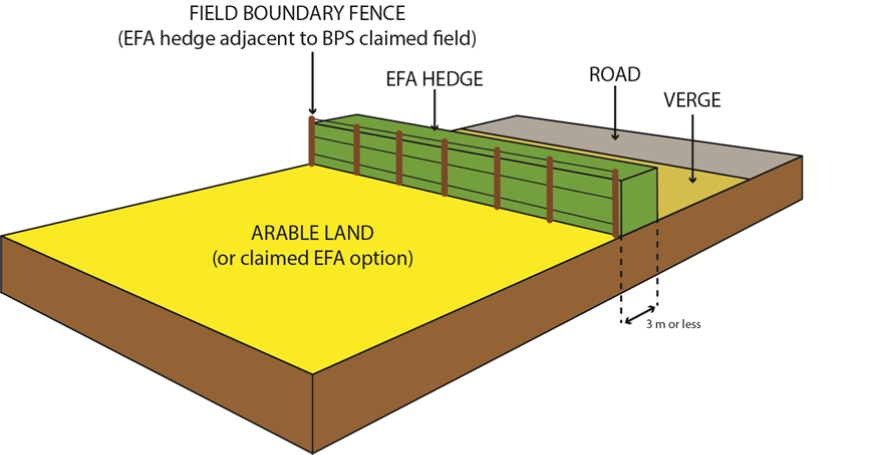
Example two – EFA hedge with a road adjacent to it
In this example the hedge is eligible to be claimed as an EFA hedge as the hedge is greater than 20 metres in length and it is within five metres of arable land. The farmer will claim using code EFAH100.

Example three – hedge with only shortest side touching arable land
In this example the hedge is ineligible to be claimed as an EFA hedge as the hedge is surrounded by permanent grassland on its longest sides and is only adjacent to arable land on its shortest side.

Example four (A) – hedge claimed as an EFA hedge shared between two farmers
In this example a ‘march’ hedge is to be claimed as an EFA hedge by both farmer A and farmer B. As the field boundary runs along the centre of the hedge, each can claim their respective half of the hedge.
Both farmer A and farmer B would claim using code EFAH50 for their respective half of the hedge.
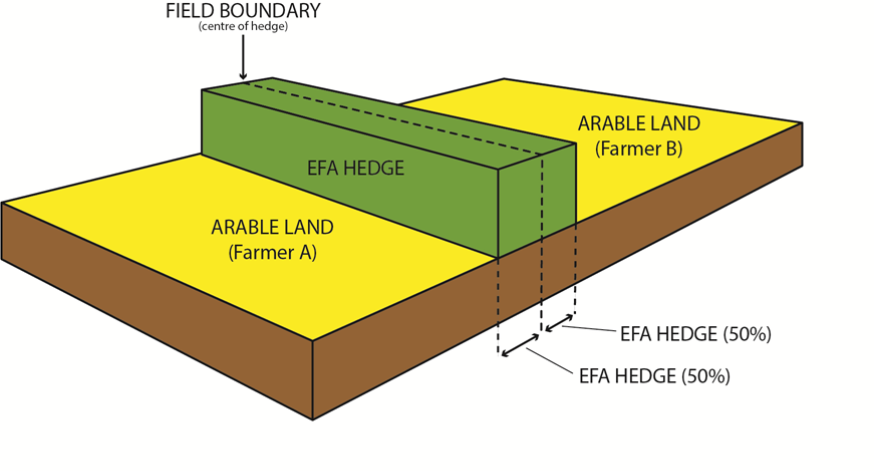
Example four (B) – boundary hedge between two arable parcels claimed as an EFA hedge by one farmer
In this example, the field boundary runs along the centre of the hedge. Farmer A can claim either EFAH50 in both of the parcels or claim EFAH100 in one of the parcels.
Please note the entirety of the hedge can only be claimed once, either claiming EFAH50 twice or EFAH100 once.
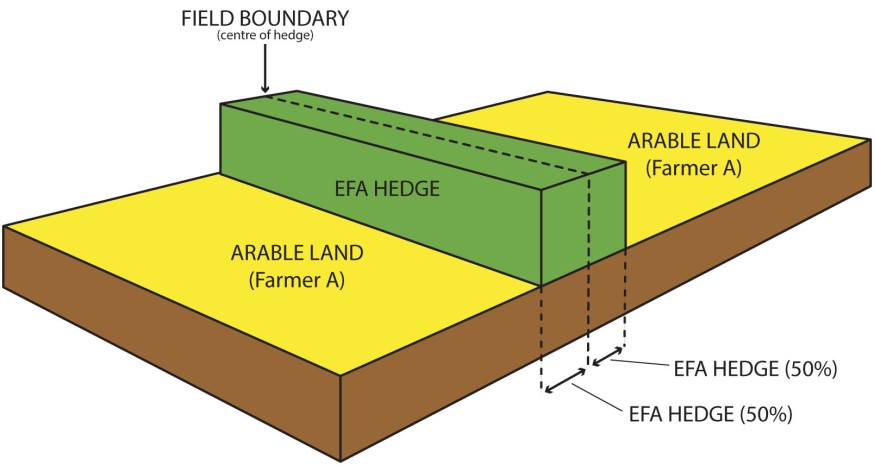
Example five – hedge claimed as an EFA hedge by one farmer
In this example the hedge is to be claimed as an EFA hedge by only farmer A as the field boundary stops on the fence, only farmer A can claim the hedge and will claim 100%, using the code EFAH100.
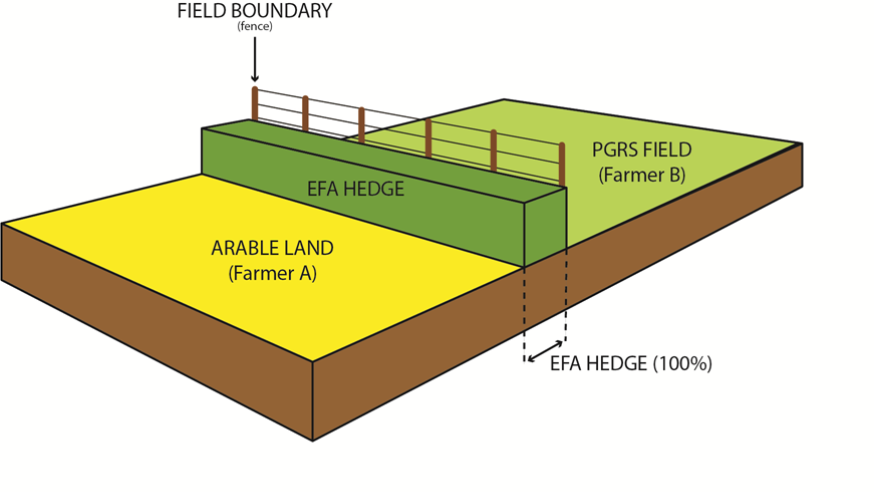
EFA agro-forestry (EFAAF) including small and farm woodland
The environmental benefits of agro-forestry systems are that they provide a diversity of habitats for wildlife and can reduce run-off and soil erosion.
What land is eligible to support EFA Agro-forestry?
Your land:
- must be permanently held by your business
- must have been BPS eligible, arable land
- must have been planted under a Forestry Grant Scheme (FGS) (Pillar 2) Scheme since 2015
Requirements for EFA Agro-forestry
You must:
- retain an EFA map relevant to your Single Application Form, detailing the location and size of your EFA Agro-forestry. See mapping requirements
- ensure that the area is subject to an agreement with Scottish Forestry under agro-forestry (FGS082-01 or FGS082-02) and have been planted since 1 January 2015 or subject to an agreement with Scottish Forestry under Woodland creation – small or farm woodland’ scheme (FGS081-009)
Helpful tips for EFA Agro-forestry
- for further details regarding Woodland creation – small or farm woodland’ scheme (FGS081-009) requirements, please refer to the Forestry Grant Scheme guidance or the Agroforestry guidance
- if you want to include areas in your EFA that are currently part of an agro-forestry grant scheme you can do this. However:
- you must ensure that the management of the two schemes are compatible
- the payment you receive for your agro-forestry grant scheme may be reduced to reflect the Greening payment you receive for your EFA feature
- there may be delays in the payment of your Basic Payment as both schemes will need to be validated
The following options are new for 2026.
EFA low input grassland (EFALIG)
The aim of this new option is to create low input grassland which is managed for grazing or cutting. This will enhance soil structure, increase biodiversity, improve water quality and limit carbon release. Costs to the business are reduced.
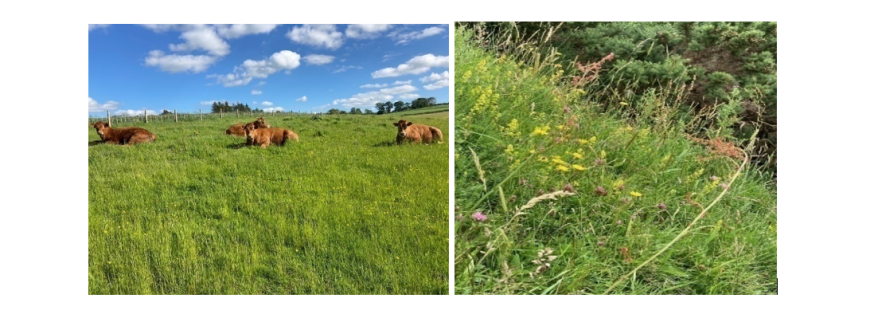
What land is eligible to support EFA Low Input grassland?
Your land:
- must be on permanent grassland
- must be on your holding, claimed as PGRS, Basic Payment Scheme eligible, agricultural parcel and claimed on your Single Application Form
- minimum size is 0.01 ha
- must be clearly identifiable and distinguishable on the ground from 1 January to 31 December, inclusive
Requirements for EFA Low Input grassland
You must:
- retain an EFA map relevant to your Single Application Form, detailing the location and size of your EFA Low Input Grassland. See mapping requirements. You will be required to produce this at inspection
- manage fields for grazing by carrying out one of the following:
- grazing
- rotational grazing, with rest periods
- cutting for hay or haylage – with the grass tedded out
- abide by any management plans on designated sites
- where this EFA Management is used on SSSIs and priority habitats, graze or cut to maintain the appropriate sward height for the grassland type
- manage grazed pasture with limited nutrient inputs – see “you must not” and “you are allowed” sections below
- leave margins uncut
- where fields are cut for forage, leave an uncut margin of least a 3 metres width to produce flowers and seed
- it must be grazed after the grass has set seed
You must not:
- manage this option on Rough Grazing
- apply inorganic fertiliser
- allow overgrazing
- poach or track the area
- carry out supplementary feed of forage:
- on areas of species-rich grassland
- within 10 metres of open water
You are allowed to:
- Spread organic fertiliser, including FYM and seaweed.
Helpful tips:
- try to keep an average sward height of at least 5 centimeters over at least 75% of the area of grazed pasture during the growing season.
- while no supplementary feeding is a requirement to limit poaching on EFA Low input Grassland or within 10 metres of open water it is acknowledged that there may need to carry out short-term feeding of stock, with straights or a blend of hard feeds
- hedges and ditches defined as eligible landscape features under GAEC (hedges up to 3 metres wide and ditches up to 2 metres wide), may be included as part of an EFA Low Input grassland
EFA herb and legume rich pastures (EFAHLRP)
The aim of this new option is to attain and maintain species diversity in existing rotational grass swards by over-seeding or reseeding with diverse species grass mix. This will extend the period of grassland in an arable rotation, building organic matter, and minimising cultivations which release Carbon.
This action will improve soil health and improve habitat conditions for pollinating insects, wild birds and small mammals, and can improve livestock health and performance.
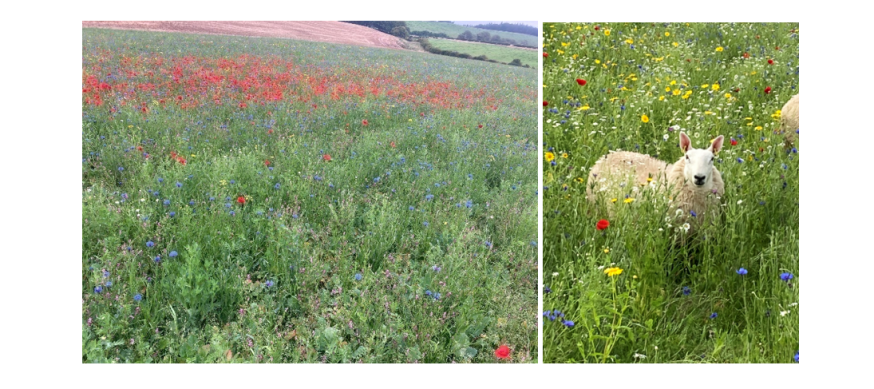
What land is eligible to support EFA Herb and Legume Rich Pastures?
Your land:
- must be claimed as arable land (including TGRS) in 2025 or later
- must be on your holding, on a claimed, Basic Payment Scheme eligible, agricultural parcel and claimed on your Single Application Form
- must be a minimum of 0.01 hectares in size
- must be clearly identifiable and distinguishable on the ground from 1 January to 31 December inclusive
Requirements for EFA Herb and Legume Rich Pastures
You must:
- retain an EFA map relevant to your Single Application Form, detailing the location and size of your EFA Herb and Legume Rich Pastures. See mapping requirements
- ensure that there are at least three different herbs or legumes from the table below in your pasture mix on your claimed EFA area to extend the flowering period for pollinators. The mix must include at least 1 legume
- ensure evidence of diverse seed mix is retained – for example a seed label confirming three or more herbs and legumes (must include at least 1 legume)
- maintain the sward until at least 31 December
You are allowed to:
apply lime, and Phosphate (P) or Potassium (K) fertilisers – see further guidance in best practice.
|
Enhanced Greening EFA Herb and Legume Rich Pastures Must contain at least three herbs or legumes and must include at least one legume |
||
|---|---|---|
| Legumes | Other Herbaceous Species | Suitable Grasses |
|
Bird’s-foot Trefoil Lucerne Sainfoin Red Clover White Clover Crimson Clover Sweet Clover Alsike Clover Vetch Berseem Clover |
Burnet Chicory Poppy Yarrow Plantain Cornflower Ox-eye Daisy Sorrel Sheep’s Parsley |
Common Bent Crested Dog’s Tail Red Fescue Sheep’s Fescue Cock’s Foot Sweet Vernal Grass Smooth-Stalked Meadow Grass Yorkshire Fog Creeping Bent Timothy Rye Grasses |
You must not:
- apply inorganic Nitrogen fertiliser or any plant protection products to the area of EFA Herb and Legume Rich Pastures. An exception is spot herbicide application for injurious weeds, invasive weeds and other weed species (refer to the Overview for guidance on Cross Compliance requirements)
- manage this option on existing species rich or Permanent Grassland
Best practice tips for EFA Herb and Legume Rich Pastures:
- in year of establishment the EFA Herb and Legume Rich Pasture does not have to be in place on 1 January but should be established by 1 July
- this Grassland can be in place for multiple years and does not have to be cultivated every year and does not have to be destroyed after the 31 December
- select species that suit soil type. Producers should consider pH, and nutrient status of soil and use appropriate species. Species choice is not restricted to wild flowers, and producers can use clovers and other legumes on more fertile ground
- it is acknowledged that there may need to be short-term feeding of stock, with straights or a blend of hard feeds. Care should be taken in identifying a suitable location for this to avoid any unnecessary damage to sensitive habitats
- hedges and ditches defined as eligible landscape features under GAEC (hedges up to 3 metres wide and ditches up to 2 metres wide), may be included as part of an EFA Low Input Grassland or managed as EFA Hedge in conjunction with the EFA Herb and Legume Rich Pasture
- if applying organic manures or lime to these fields, soil sampling should take place prior to application to assess whether the application is required - and if so, to ascertain the most suitable application rate. Legume rich grassland may not require lime or organic manure and application could lead to a reduced diversity of species within the sward
- reduction of inputs on this type of grassland is a way to improve profitability
- best practice is to regeneratively graze Herb Rich and Legume Rich pastures with cattle
- rotational grazing; for example grazing heavily for a short period of 1 or 2 days then resting for 42 days before grazing or cutting. Cutting can be useful for taking paddocks out of the rotation for mowing or shortening or lengthening the time cattle graze in a paddock
- EFA Herb and Legume Rich Pasture is beneficial for grazing animals (anthelmintic species, varied dietary mineral uptake) and for soil health
- use wildlife friendly mowing techniques to reduce mortality
- a higher vegetative output can be achieved with regenerative grazing
- where cutting for winter forage, the sward should be cut after the herbs and legumes have gone to seed. After cutting, the crop should be tedded to allow the seeds to shed. This will help to maintain the diversity of species
- when cutting, cut in a wildlife friendly manner where possible, and avoid topping during nesting periods where possible
- areas that are subject to flooding or close to river banks could be managed for flood alleviation or wildlife habitat (e.g. beaver habitat) Increasing diversity helps carbon capture in low carbon soils, though some may be at capacity. Land with a higher organic matter content has increased absorbency and improved water infiltration
EFA unharvested crop (EFAUHC)
Areas of Unharvested Crop can provide an important habitat for farmland biodiversity, contribute to wildlife and ecological networks and benefit water quality.
Conservation headlands, around arable fields are a valuable feature for farmland biodiversity but also support sustainable food production. They support crop pollinators, and function as a wildlife refuge after harvest. They can also prevent nutrient leaching and soil erosion.

Photo credit: Hywell Maggs
What land is eligible to support Unharvested Crop?
Your land:
- must be on, arable land
- can be around the margin of a field (this can be one side) or splitting two crops within a field
- must be on your holding, on a claimed, Basic Payment Scheme eligible, agricultural parcel and claimed on your Single Application Form
- must be between 6 and 20 metres wide
- must be a minimum of 0.01 hectares in size
- must be clearly identifiable and distinguishable on the ground
Requirements for EFA Unharvested Crop
You must:
- retain an EFA map relevant to your Single Application Form, detailing the location and size of your EFA Unharvested crop. See mapping requirements
- maintain the area of Unharvested Crop until at least 31 December in the year of claim
- establish a single species; spring / autumn-sown cereal or oil-seed crop, or a spring sown pea or pulse crop.
- control injurious weeds, invasive weeds and certain other weed species by spot herbicide application or hand rogueing. You must not breach GAEC – refer to the Overview for guidance on GAEC requirements
You must not:
- apply any plant protection products to the area of unharvested crop from 1 January to 31 December inclusive, except by spot herbicide application for injurious weeds, invasive weeds and other weed species (refer to the Overview for guidance on GAEC requirements)
- apply any fertiliser with the exception that you may apply Phosphate or Potassium fertiliser to maintain soil fertility.
- graze the Unharvested Crop before 31 December
- use for regular access
You are allowed to:
- under sow the Unharvested Crop with a grass seed mix
- apply Phosphate or Potassium fertiliser to maintain soil fertility
- graze after 31 December
Helpful tips for EFA Unharvested Crop
- establishing next to Hedges and Field Margins creates a good Biodiversity Mix
- if the EFA UHC splits two crops these can be the same crop (such as a field of winter barley split in two by an EFA UHC)
EFA agro-forestry low density planting (EFAAFLDP)
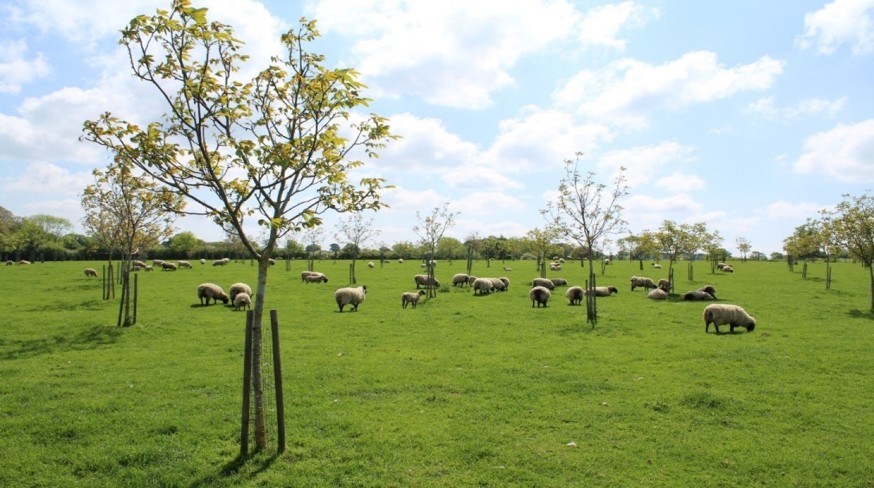
Photo credit: Forestry Commission
The environmental benefits of agro-forestry systems are that they provide a diversity of habitats for wildlife and can reduce run-off and soil erosion, provide shade for Livestock, and potentially provide income diversification.
What land is eligible to support EFA Agro-forestry Low Density Planting?
Your land:
- must be permanently held by your business
- must have been BPS eligible, arable land, or Permanent Grass Land, not Rough Grazing.
- minimum Area 0.5 hectares
Requirements for EFA Agro-forestry Low Density Planting
You must:
- retain an EFA map with your Single Application Form, detailing the location and size of your EFA Agro-forestry Low Density Planting. See mapping requirements
- declared area must have Low density (20 to 50 trees per hectare) / Protected with Cactus guard or similar and or plastic tree guard on Permanent Grassland. Or in arable situations trees should be planted in rows, spaced to enable machinery to operate in arable field. Protected with appropriate guards to prevent browsing
- trees must be native trees, including fruit trees
Helpful tips
- Scottish Forestry - Environmental Impact Assessments - If you are planning to plant trees you should check to see if the area you intend to plant is in a sensitive area. If it is there are thresholds that you may apply. Check if you are above or below the EIA screening threshold in the link above
- in arable situations you could plant the native trees in strips sown with a wildflower/grass mix
- if you want to include areas in your EFA that are currently part of an agro-forestry grant scheme you can do this. However:
- you must ensure that the management of the two schemes are compatible
- the payment you receive for your agro-forestry grant scheme may be reduced to reflect the Greening payment you receive for your EFA feature
- there may be delays in the payment of your Basic Payment as both schemes will need to be validated
General tips for all EFA options
- if you are unsure if your use of an area for access or tracking is more than occasional use then you should not use this as an EFA fallow area. Any consequences arising from access by a third party inconsistent with the Land Reform Act and the associated access guides will not be considered a breach of an EFA
- the definition of ‘plant protection products’ can be found at the following link: Definition of Pesticides
- if you use temporary grass as EFA fallow, this land will retain its arable status for Greening purposes (including your commitment to have 5% of your arable land subject to EFA). This applies for as long as you continue to use it for EFA fallow even if the grass becomes more than five years old
- remember – your arable land includes any temporary grassland that you include in a crop rotation. Temporary grassland is grassland that is five years old or less. If you plough permanent grass and immediately sow a new grass ley, the land will retain its status as permanent grass and does not become temporary grass
- if you choose to claim an EFA margin on permanent grassland, open grazed woodland or rough grazing – it must be adjacent to, or within 5 metres of arable land or contiguous to a claimed EFA option. You must claim this land as Permanent Cover (PC) on your Single Application Form. This permanent cover will be considered as arable land when calculating your total area of arable land for your Greening requirements including the area of EFA
- if you wish to undertake multiple EFA options in one field you can do this as long as you meet all the eligibility requirements of each and you are able to distinguish the location and extent of each option. In a practical example, this means you could have an area of fallow surrounded by a margin
- land can only count once as EFA so, as detailed above, you may have different EFA options in the same field, but the land can only contribute to your EFA commitment once. For example, it cannot be EFA fallow and EFA green cover in the same claim year
- many elements of EFA are complementary to GAEC. This means that margins or hedges can meet both GAEC and EFA requirements and be eligible land for the Basic Payment Scheme. Refer to the Overview for guidance on GAEC requirements
- there is no upper limit to the area you can manage and claim as EFA. So if you have a commitment of 10.6 hectares you can manage and claim above this figure. For example, 12.2 hectares, if you wish
- if you want to include areas in your EFA that are currently part of an agri-environment scheme you can do this. However:
- you must ensure that the management of the two schemes are compatible
- the payment you receive for your agri-environment scheme may be reduced to reflect the Greening payment you receive for your EFA feature
- there may be delays in the payment of your Basic Payment as both schemes will need to be validated
Flexibility under Greening rules
| What is permitted under Scottish Greening rules within the Ecological Focus Areas (EFA's) as of 20 May 2025 | |
|---|---|
| EFA fallow | Although no agricultural activity is allowed in EFA fallow between 15 January and 15 July, agricultural activity can be resumed after 15 July. |
| EFA margins | Can be grazed or cut from 15 July with the exception that livestock cannot graze in margins that contain or are adjacent to a watercourse. |
| EFA catch crops | The catch crop (grass) must be maintained until 31 December however, grazing can take place after the nurse crop (cereal) has been harvested. |
| EFA green cover |
This has been updated to allow grazing once the farmer feels there is a suitable level of cover established. The land cannot be cultivated after green cover establishment until after 31 December. |
| EFA nitrogen fixing crops | Can be grazed or cut after 1 August with the exception that livestock cannot graze associated margins that contain or are adjacent to a watercourse. |
| EFA agro forestry including small and farm woodland | |
| EFA low input grassland | The strips sown with a wildflower / grass mix can be cut or grazed. |
| EFA herb and legume rich pasture | Can be grazed, or cut for winter forage after the herb and legumes have gone to seed. |
| EFA unharvested crop | You can under sow the Unharvested Crop with a grass seed mix and graze after 31 December. |
| EFA low density planting | Normal agricultural activities under taken between the trees. |
Previous versions
Download guidance
Click 'Download this page' to create a printable version of this guidance you can save or print out.
